ASRock Rack C2750D4I Review: A Storage Motherboard with Management
by Ian Cutress on April 29, 2014 9:00 AM EST- Posted in
- Motherboards
- Storage
- Atom
- ASRock
- Silvermont
- Enterprise
- server
- Avoton
ASRock C2750D4I In The Box
Server motherboard packages are almost confusing. On the one hand it is a premium product that should get premium treatment, especially if it is end-user facing rather than server customer facing. The counter argument to this comes from server motherboard users knowing exactly what they want to use, so why waste money adding equipment that might not be applicable? The variation of cases or server chassis mean it is almost pointless to add something like a USB bay or rear bracket.
Nevertheless ASRock offers the following with the C2750D4I:
Driver DVD
Manual
Rear IO Shield
Four SATA Cables
Being a motherboard aimed at storage we should be glad that at least some cables are there, but this is only 1/3 of the number of SATA ports on the motherboard. In a server case I would imagine that all the cables are of appropriate length, and that can be hard to judge – so some is better than none but not as useless as more. If that makes any sense.
Many thanks to...
We must thank the following companies for kindly providing hardware for our test bed:
Thank you to OCZ for providing us with 1250W Gold Power Supplies and SSDs.
Thank you to ADATA for providing us with memory.
Thank you to ASUS for providing us with the AMD HD7970 GPUs and some IO Testing kit.
Thank you to MSI for providing us with the NVIDIA GTX 770 Lightning GPUs.
Also thank you to Silverstone for sending us the DS380 case.
Test Setup
| Test Setup | |
| Processor |
Intel Avoton C2750 8 Cores, 2.4 GHz (2.6 GHz Turbo) |
| Motherboards | ASRock C2750D4I |
| Cooling | Basic 8cm Fan |
| Power Supply |
OCZ 1250W Gold ZX Series Silverstone 300W SFX PSU |
| Memory | ADATA XPG V1.0 2x8GB DDR3L-1600 9-11-9 1.35V Kit |
| Memory Settings | XMP |
| Video Cards |
MSI GTX 770 Lightning 2GB (1150/1202 Boost) ASUS HD7970 3GB (Reference) |
| Video Drivers |
AMD Catalyst 13.12 WHQL NVIDIA Drivers 332.21 WHQL |
| Hard Drive | OCZ Vertex 3 256GB |
| Optical Drive | LG GH22NS50 |
| Case | Silverstone DS380 |
| Operating System | Windows 7 64-bit SP1 |
| USB 2/3 Testing | OCZ Vertex 3 240GB with SATA->USB Adaptor |
Power Consumption
Power consumption was tested on the system as a whole with a wall meter connected to the OCZ 1250W power supply, while in a single MSI GTX 770 Lightning GPU configuration. This power supply is Gold rated, and as I am in the UK on a 230-240 V supply, leads to ~75% efficiency > 50W, and 90%+ efficiency at 250W, which is suitable for both idle and multi-GPU loading. This method of power reading allows us to compare the power management of the UEFI and the board to supply components with power under load, and includes typical PSU losses due to efficiency. These are the real world values that consumers may expect from a typical system (minus the monitor) using this motherboard.
While this method for power measurement may not be ideal, and you feel these numbers are not representative due to the high wattage power supply being used (we use the same PSU to remain consistent over a series of reviews, and the fact that some boards on our test bed get tested with three or four high powered GPUs), the important point to take away is the relationship between the numbers. These boards are all under the same conditions, and thus the differences between them should be easy to spot.
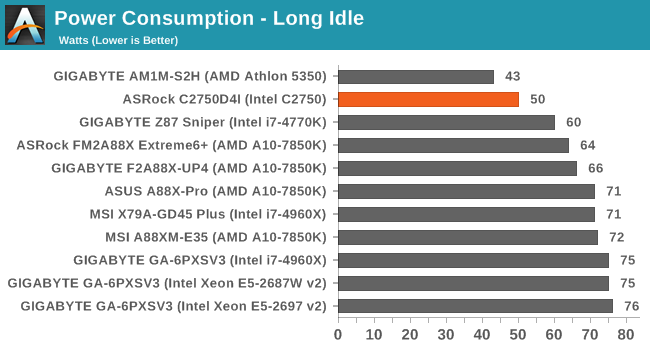
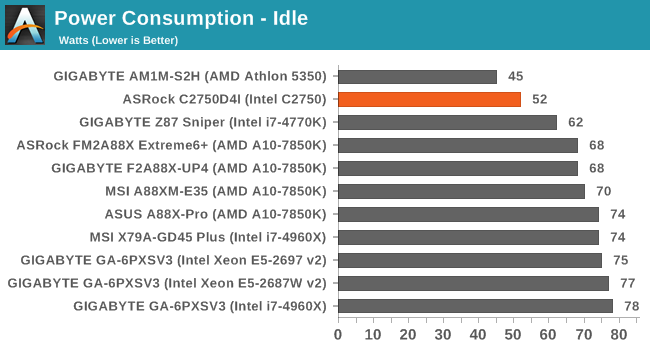
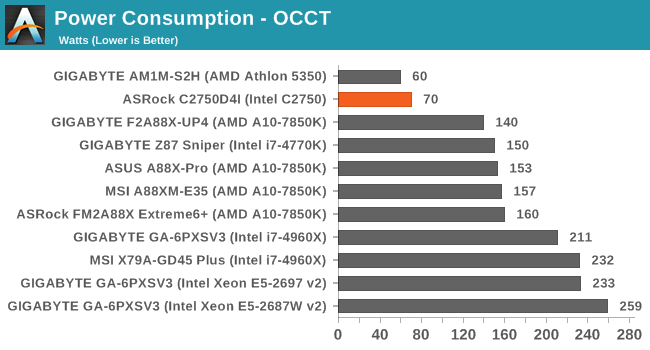
We added in the results from our 25W Kabini platform we are currently testing for a future review, just to show how much difference having the extra controllers and the remote management effects our idle and power loadings. It would therefore reveal that the extra featureset on the C2750D4I equates to 7-10W on our test bed.
Windows 7 POST Time
Different motherboards have different POST sequences before an operating system is initialized. A lot of this is dependent on the board itself, and POST boot time is determined by the controllers on board (and the sequence of how those extras are organized). As part of our testing, we are now going to look at the POST Boot Time - this is the time from pressing the ON button on the computer to when Windows 7 starts loading. (We discount Windows loading as it is highly variable given Windows specific features.) These results are subject to human error, so please allow +/- 1 second in these results.
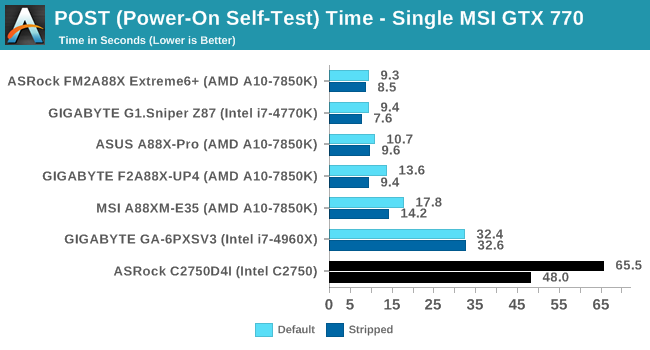
The issue with remote management systems is always the pre-initialisation time, which on the C2750D4I is unforgiving. However, it is often not a focus of a system such as this which might remain in constant operation for several years without a restart.


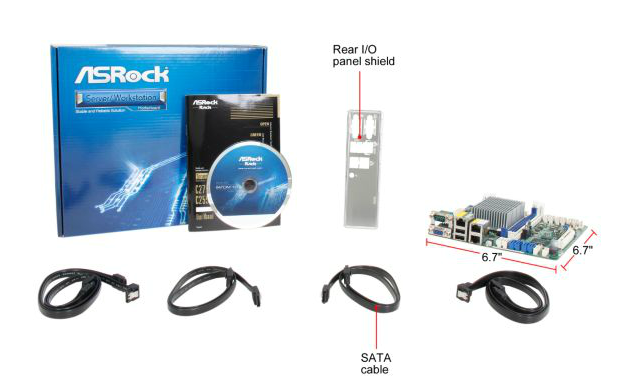








85 Comments
View All Comments
mars2k - Saturday, May 31, 2014 - link
I'm with you Up, how did this get sidetrac'd into HTPC, I'm looking for an alternative to some of the stock Qnap and Synology geer for use in my home. Want NAS box with lots of tru put. Not clear on why Ian says no NAS. Whats up with configuring as a NAS? Any other suggestionssamueldes - Thursday, November 27, 2014 - link
Before you buy: the Areca PCIe X8 card won't fit in the ASUS AM1 board with only one PCIe X4 slot.Ammohunt - Wednesday, April 30, 2014 - link
Avoton supports intels visualization extensions with 64GB of RAM and 8 cores it could be a decent low powered KVM server sliced up in many different ways.stoatwblr - Wednesday, April 30, 2014 - link
I have to say I'm surprised they didn't go with minisas connectors instead of a fistful of satas. Supermicro have done the same thing and it simply doesn't make sense.Samus - Friday, May 2, 2014 - link
yeah they could have saved a ton of real estate using mini plugs. Even full sized servers like HP's ML310 series use mini plugs to keep the board clean. Even more important on an ITX board. This board has a lot of oversights, which ASRock will learn is unacceptable in the market they're targeting it at.ericloewe - Friday, May 2, 2014 - link
Bad idea in this case, since they're using SATA instead of SAS. Someone would inevitably try to use this with an SAS expander...But I agree with Supermicro having made an odd choice. Their LSI2308-equipped motherboards would be perfectly equipped with SAS connectors.
speculatrix - Sunday, May 4, 2014 - link
if you're looking more for a media player you can plug into your TV, then one of the many other Baytrail-D motherboards would be suitable... there's a useful list and discussion of them here:http://www.silentpcreview.com/forums/viewtopic.php...
bernstein - Tuesday, April 29, 2014 - link
i'm probably one of the core target prosumers for this, as for a few years now i've been running something similar at home...namely a sandybridge itx board, 35 Watt i3, ecc ram, supermicro low profile (lsi) sas controller, supermicro 24x (lsi) sas expander backplane, 400w passive psu, passive cpu cooler, 18 sata 2.5" hdds (5200rpm - WD scorpio blue / hitachi travelstar)
and while this board fits my requirements wonderfully while being cheap there is just one dealbreaker... 12x sata? wtf? no-one sane will run so many hdds without a backplane. it's just unmanageable.
the most simple backplane with 12 sata plugs + some power plugs & 12 correctly spaced hdd plugs woud do. and could be manufactured & sold very cheaply. but there is no such thing... (step up asrock :)
bernstein - Tuesday, April 29, 2014 - link
to the point: give me such a backplane for below $100 and im sold. else thanks but no thanks.ZeDestructor - Tuesday, April 29, 2014 - link
With 18 drives, you might want to consider a BackBlaze pod with room for 45 drives, especially now that we have 32 and 40 disk controllers. That with some ZFS would be quite an excellent NAS IMO, and I am heading that way, slowly.